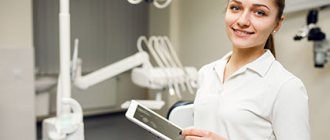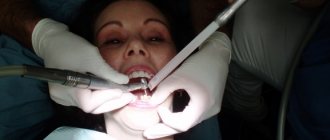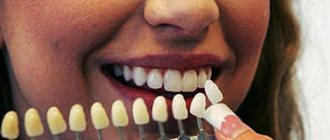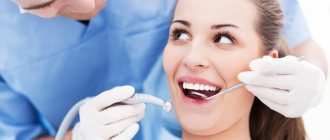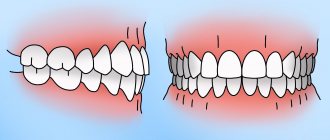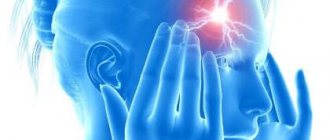When studying the price list of any dental clinic, patients see something like the following:
If everything is more or less clear with the first and last points, then what about an orthopedic dentist, periodontist, implantologist and orthodontist? Who are they and what do they do? And which of them wears dentures?
Everything is simple here:
- Dentist-therapist: treats caries, pulpitis and periodontitis, puts fillings. Works with tooth root canals. In our clinic, therapists are trained in artistic dental restoration.
- Dentist-surgeon: removes teeth, performs tooth-preserving operations. If he has the necessary knowledge, he carries out the surgical part of dental implantation - the direct installation of the implant.
- Orthopedic dentist: deals with dental prosthetics. Crowns, inlays, removable dentures are his element. Orthopedic dentists also perform prosthetics on implants that are pre-installed by his colleague, a dental surgeon.
- Dentist-periodontist: gum disease is the domain of the periodontist. Bandages, mouthguards, ointments are his arsenal. Performs hygienic cleaning of the oral cavity (tartar removal, Airflow). In difficult cases, he performs operations on the gums (periodontics is a discipline related to surgical dentistry).
- Implantologist: deals with the installation of dental implants and subsequent prosthetics on them. Sounds familiar? That's right, a dental surgeon and an orthopedic dentist can do the same thing, working in tandem.
- Orthodontist: corrects bites for adults and children. His tools are plates, trainers, and bracket systems. As a result, orthodontic patients receive straight teeth and their correct alignment.
- Pediatric dentist: deals with the treatment and removal of baby teeth, silvering. It can promptly prompt parents that it is time for their child to see an orthodontist in order to solve a bite problem at an early age.
Who is an orthodontist and does he install braces?
Doctors who eliminate defects in the dentofacial apparatus and correct the position of teeth are called orthodontists. Such a doctor corrects interdental gaps, crooked teeth, incorrect jaw position and much more. In his work, an orthodontist uses braces, plates and other devices that eliminate bite defects.
Orthodontists began to appear in Russia back in the Soviet years. If in those days dentists corrected defects solely according to indications, then in new Russia orthodontic treatment is increasingly used for aesthetic purposes.
The problems with which patients come to the orthodontist are divided into three categories:
- Congenital pathologies associated with underdeveloped teeth, their absence or irregular shape.
- Genetic inheritance, which leads to malocclusion, crowded teeth, large interdental spaces.
- Defects acquired during life, for example, these include crooked front teeth.
Where to apply
To make training in this specialty possible, it is worth enrolling in the following universities in Moscow and other Russian cities:
- Kuban State Medical University;
- Altai State Medical University;
- St. Petersburg Institute of Dentistry;
- Moscow State Medical and Dental University;
- Ryazan State Medical University;
- Russian Medical Academy of Postgraduate Education;
- Northern State Medical University.
There are many other universities in the Russian Federation that offer training in specialties in this area.
Who is an orthopedist?
The main task of an orthopedist is to restore the dentition and provide dental prosthetics. In orthopedic dentistry, patients are offered to restore lost teeth, and if this is not possible, replace them with implants. New artificial teeth function like real teeth and are in no way inferior in appearance.
The prosthetic procedure is preceded by the collection of tests, examination of the whole body and oral cavity. Only after this the doctor begins to manufacture the prosthesis, taking into account the patient’s characteristics.
What does an orthopedist do? Takes impressions and also manufactures structures for prosthetics, which include crowns, inlays, and bags. After completion of the procedure, the orthopedist corrects prosthetic defects so that the implants do not cause discomfort to the patient.
Disciplines studied
During their studies, the student will study the following subjects:
- human anatomy and physiology in the course of biomechanics of the jaw system;
- dental materials science with a labor protection course;
- dental diseases;
- basics of orthopedic dentistry;
- production of removable laminar dentures;
- production of fixed prostheses;
- hygiene and epidemiology of emergency situations;
- examination methods in dentistry;
- organization of health and public health, etc.
What is the difference?
What is the difference between an orthopedic dentist and an orthodontist, read below.
Firstly, the activities of doctors are aimed at correcting various defects . An orthodontist works with dental anomalies, he straightens teeth and improves chewing function. An orthopedist specializes in restoring decaying teeth and installing implants.
If you evaluate Internet queries, it becomes clear that people do not always understand which doctor they need to see - an orthodontist or an orthopedist.
It is worth remembering that orthodontists are found only in dentistry. At the same time, orthopedics is a broader concept, so such a doctor can work not only in a dental clinic. There are orthopedists who deal with problems with the musculoskeletal system.
Duration of training
The duration of training and the form are closely interrelated. You can study at:
- full-time;
- individual form.
There is no correspondence form for this specialty. For full-time study, the duration will be 2 years, and for individual study, it is set at the discretion of the educational institution. However, it can increase to no more than three years.
When should you contact an orthodontist?
First of all, children need to consult a doctor. It is better to schedule the first visit to coincide with the 2nd or 3rd birthday, and repeat the next visit at the age of five, when baby teeth begin to change to permanent ones. It is also necessary to visit a doctor if the teeth are not growing properly, as well as if the child has bad habits or congenital anomalies. Timely treatment will prevent severe correction in older age.
Other reasons to visit an orthodontist include:
- Improper closing of the jaws.
- Premature loss of baby teeth.
- Impaired diction.
After the diagnosis is made, the doctor will select the optimal treatment method and send the patient for preparation. Before the orthodontist begins his work, caries and plaque must be removed.
Today, there are many models of braces that will not spoil a person’s appearance.
For example, on some products the plates are positioned so that they can be easily attached to the back of the teeth. There are also ceramic braces that become almost invisible due to the fact that they blend with the shade of tooth enamel.
Here are a few methods that orthodontists use in their work.
- Myotherapy . This is the most gentle method and is most often used when working with children. It is a kind of gymnastics that helps the bite and jaw form correctly. It is used only during the period of growth of the dentofacial apparatus.
- Hardware method involves the use of braces, aligners, plates. Suitable for both adults and teenagers. To eliminate dental defects, you will have to be patient, because the process is quite long and consists of two stages.
- First, the doctor needs to fix the problem, for example, prescribe a course of treatment with orthodontic devices. This stage can last from six months to several years. The entire period of treatment should be shown to the orthodontist for monitoring and adjustment if necessary.
- After achieving results, a retention stage follows to consolidate the effect obtained. When an orthodontic structure is removed from the mouth, a retention device is placed in its place - a thin wire that holds the teeth together on the back side. With such a design you will also have to walk for a certain time.
- The surgical method is used in extreme cases when other methods do not bring results. Usually prescribed for serious problems of the jaw system, as well as in the presence of crowded teeth. The orthodontist prepares the patient for the operation, and the dental surgeon performs it.
The bracket system is considered the most effective, but aligners are becoming increasingly popular today. These are transparent elements for each tooth, which, thanks to the material, remain completely invisible.
Future profession
The specialty of an orthopedic dentist requires excellent knowledge of the biomechanics of the dental system. Based on his knowledge, the doctor will be able to offer his patient options, take dental impressions, create dentures or implants, then try them on, make adjustments and finally fix them in the oral cavity.
The future orthopedic dentist will be able to:
- determine the patient’s condition, provide first aid if necessary and refer the patient for hospitalization;
- conduct a complete examination of the patient’s oral cavity, make conclusions about the patient’s mucous membrane, gums, soft tissues and teeth;
- determine the feasibility of various laboratory research methods;
- diagnose dental diseases in people of different ages, justify your diagnosis;
- anesthetize the patient’s mouth and jaws;
- perform prosthetics and dental implantation in the presence of diseases and pathological conditions;
- make splints, spoons, mouthguards and other devices individually in each case;
- Monitor the patient’s condition and complete all medical documentation in accordance with current requirements.
All this knowledge will allow the future orthopedic dentist to provide high-quality dental care to different age groups of patients.
In what cases do you consult an orthopedist?
Here are a number of the main problems with which patients come to dental orthopedics.
- A persistent feeling of discomfort due to the absence of one or more teeth. Often such a defect spoils the appearance of the face, which is why a person constantly feels insecure. Curvatures, cracks and chips also do not contribute to psychological comfort.
- With insufficient teeth, chewing function disorders sometimes occur. Its restoration is necessary for the normal functioning of the dental system. In addition, normalizing chewing function improves metabolic processes in the body and also helps fight periodontal disease.
- If, due to continuous destruction, there is a possibility of losing a tooth, you should contact an orthopedic dentist as soon as possible. The doctor will help stop the destruction process and save the tooth.
- To treat complete edentia, you also need to visit an orthopedist. Modern medicine easily solves the problem of missing teeth.
To carry out diagnostics, the orthopedic dentist performs an X-ray of the oral cavity, and in complex cases, a computed tomography. Sometimes additional examinations may be required.
There are three main treatment methods used by an orthopedic surgeon.
- Microprosthetics. If, despite the destruction, the roots of the tooth are still alive, this method is used. It is suitable for stains on the enamel, chipping or unevenness. To restore lost attractiveness to a smile, the doctor installs veneers on the front surface of the teeth. If there is a problem with the chewing teeth, then inlays are used.
- For permanent prosthetics, dentists install bridges and crowns. Such elements are necessary in cases where it is no longer possible to restore a tooth. Bridges are attached to installed implants or entire teeth. Crowns and bridges are considered more durable than veneers.
- For older people or children with damaged milk teeth, removable dentures are used. In the latter case, this process helps all the remaining children's teeth grow evenly. Elderly people have no alternative - implants are contraindicated for them.
When your teeth hurt, you should immediately go to the dentist . It is important to choose the right specialist who can help you. If you are at risk of losing teeth or are missing them, contact an orthopedist. To correct your teeth, you should visit an orthodontist.
Admission conditions
Admission to the specialty 08/31/75 “Orthopedic Dentistry” is possible only with a higher medical education.
Specialists who have graduated from a medical school in the following specialty can apply here:
- pediatrics;
- medical business.
Thus, for admission it will not be enough to know which subjects to take. An exam in a core subject may be scheduled at the discretion of the university.
Acquired skills
During the training process, residency offers the future specialist to fully master all the skills necessary for professional activity and consolidate the acquired knowledge in practice. Thus, the future orthopedic dentist will be able to:
- determine how mobile the tooth is;
- establish the condition of the oral mucosa, determine how pliable and mobile it is;
- probe and determine the condition of periodontal pockets;
perform eclectic diagnostics, provide high-quality anesthesia to your patients;- make two-layer or regular impressions of teeth on plaster or elastic masses;
- carry out complete preparation of the patient’s oral cavity for prosthetics, which includes the treatment of diseases of the oral organs;
- prepare the crowns and roots of teeth for the upcoming installation of dentures;
- install plastic, stamped or solid dental crowns, install pin dentures;
- apply splints made of various materials;
- perform aesthetic modeling of future prostheses, etc.
The skills that a resident acquires during the training process allow him to become a qualified specialist.

